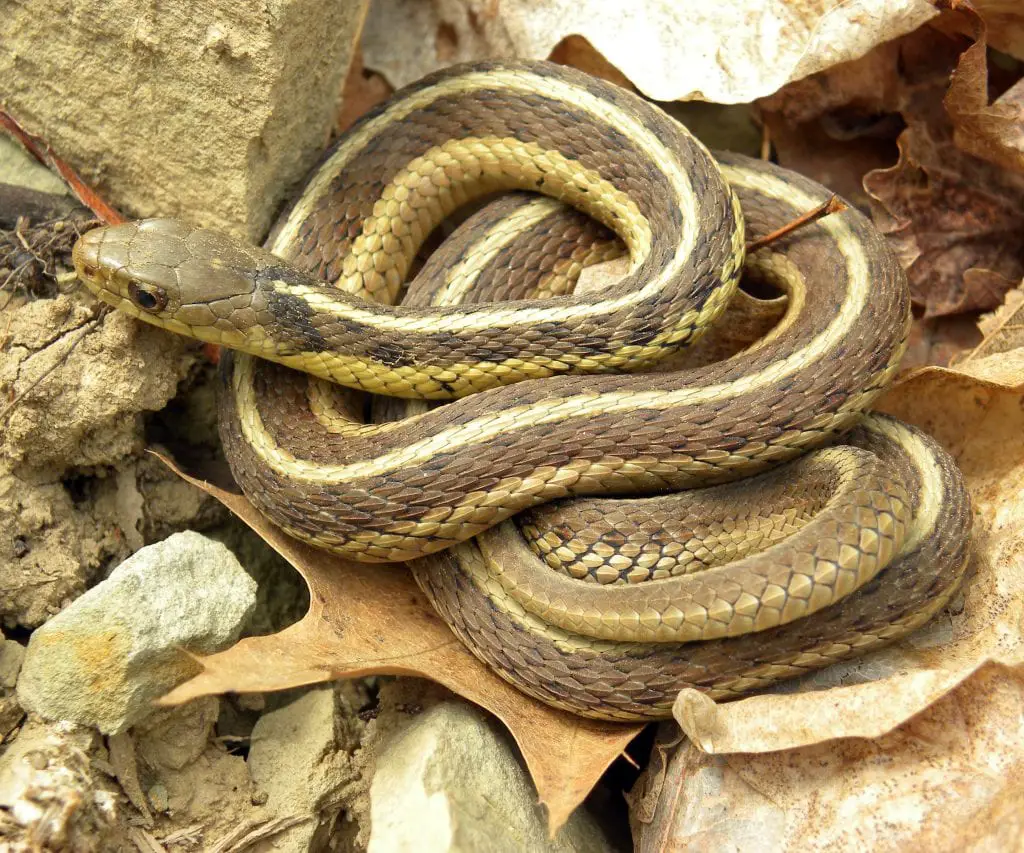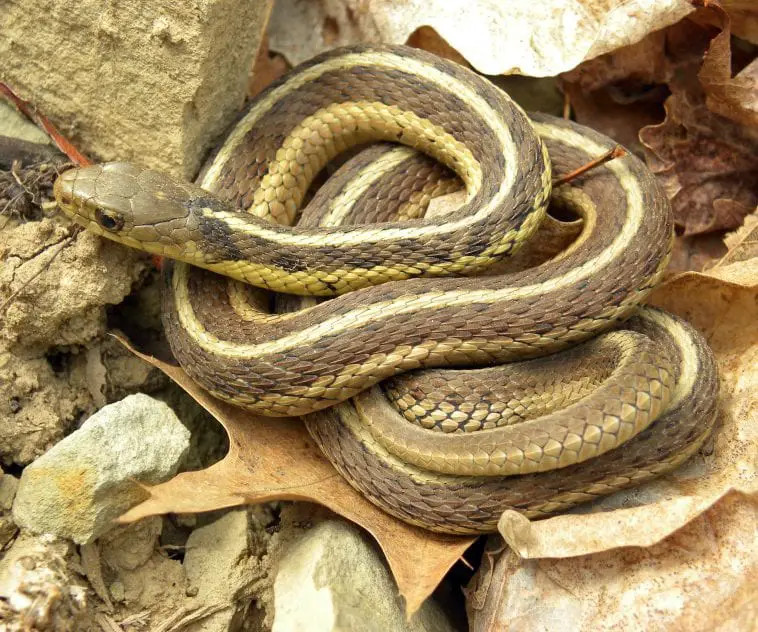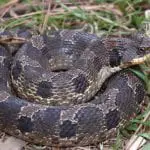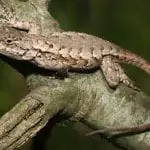Scientific Facts
| Common Name: | Eastern Garter Snake |
| Scientific Name: | Thamnophis sirtalis |
| Life Span: | 8 to 12 years |
| Size: | 18 to 26 inches long |
| Habitat: | Marshes, meadows, hillsides, and woodlands |
| Country of Origin: | Southeast and North America |
Physical Description

The Eastern Garter Snakes come in various color patterns. However, they are known for having those white or yellow stripes on their bodies that run down the center of their dark backs. These strips look like “garters” that hold up socks.
On their sides, these snakes commonly have checkboard patterns comprising of stripes and squares. It often comes with 2 rows of dark spots that run the length of their yellowish or greenish bellies.
Eastern Garter Snakes have rough or keeled scales. They may look the same with any other garter snakes, but you can distinguish the Eastern Garter Snakes with those dark bars between their labial or lip scales.
Adult snakes can grow to 18 or even 26 inches long with ridged or keeled scales and a variety in their patterns and coloration. Their backs are green, dark brown, or olive-colored with those white or yellow stripes run down the middle.
This stripe in the center of their bodies is paralleled by 2 less noticeable yellow, white, brown, bluish, or green stripes, though these stripes don’t exist at all in some cases. The gap between these stripes forms a checkerboard pattern of either green or black spots. Some people have orange or red shade on the skin between the dorsal scales. Their unmarked bellies can be yellowish-green or cream-colored.
Similar Species
The Eastern Garter Snakes are so similar to Butler’s Garter Snake, Northern Ribbonsnake, and Red-Sided Garter Snake. The side stripes on the Northern Ribbonsnake are on the 3rd and 4th scale rows. These snakes also come with a remarkable white crescent in front of their eyes, which is slimmer than that of the Garter Snakes. Also, their tails are longer than the tails of other snakes.
The side stripes on Butler’s Garter Snakes are on the 3rd and part of the 2nd and 4th scale rows. These snakes also have smaller heads than the Eastern Garter Snakes, which made their necks less visible.
The Red-Sided Garter Snakes have orange or red spots or bars between the side and back stripes. However, most Eastern Garter Snakes can also be in the dark reddish shade. This coloration often begins on the chin and will run through the body underneath the side stripe. Also, these snakes don’t have red spots or bars along their backs. The Red-Sided Garter Snakes exist in Northwest Ontario only.
The melanistic Eastern Garter Snakes can look like the Small Eastern Rat Snakes or the Water Snakes. However, those snakes do have pale patterns while the Eastern Garter Snakes don’t. These Eastern Garter Snakes also resemble the Queen Snakes that come in 2 yellowish side stripes and faint dark stripes down their backs.
Habitat
Garter Snakes, especially the Eastern Garter Snakes are common across most of the North and Southeast America. They are found in various habitats such as the woodlands, marshes, meadows, and hillsides. They prefer grassy and moist environments and are usually found near water like the edges of lakes, ponds, streams, and ditches.
On the other hand, they aren’t always found near the permanent sources of water. Sometimes, these snakes are common among the commonly-encountered snakes in the suburban regions, given there’s some cover that can be boards, debris, logs, rocks, and vegetation.
Habits
Eastern Garter Snakes can be active by day or night. They love to spend their time in feeding themselves. They can stay active across the year – even in warm winter.
Behavior
They are active throughout the day. They are active on a wider variety of temperatures compared to other snakes. The hibernation period for them starts in late October and will last until March to early April. You may also find these snakes basking on the rocks on mild winter.
They hibernate in the burrows or cavities like rodent burrows, underneath rock piles, crayfish burrows, or within the stumps. A few of them may need to travel a fairly long distance going to their brumation areas from the summer breeding and feeding sites.
As solitary animals, these snakes gather in big groups in good locations only when they need to hibernate. They do this to make sure all of them will maintain the needed body temperature to survive. As they lie together and form tight coils, the Eastern Garter Snakes can prevent the loss of body heat.
As cold-blooded animals, the eastern garter snakes require thermoregulation in controlling and maintaining the ideal temperature. They expose themselves in the sunlight in the daytime to maintain the temperature between 28 to 32 degrees Celsius during the day.
At night, their body temperature drops fast based on the kind of shelter where they prefer to stay throughout the night. To keep their body warm, these snakes often sleep in piles which makes the environment warm, just like what happens when they hibernate.
Communication and Perception
Eastern Garter Snakes are communicating through smell and touch, particularly for breeding. Before and after the breeding season, you won’t see these snakes interacting with one another. Their cleft tongues help in collecting chemicals mixed with air while inserting their tongues into the special organ found above their mouth that interpret those chemical signals known as pheromones.
These chemical signals can act as a “radar” for Eastern Garter Snakes. With a powerful sense of smell, they can find other snakes and even the trails they left by detecting the pheromones released by every snake.
After birth, the baby Eastern Garter Snakes follow a similar pheromone trail in feeding and location other garter snakes. Also, these animals seem to be too delicate to sensations. Eastern Garter Snakes are blessed to have good eyesight.
During the mating season, these snakes use systems of chemical communication. The males use skin lipids as pheromonal signals to recognize females because the skin pheromones in males and females are too different. However, some male snakes naturally have both male and female skin pheromones.
Food Habits
Eastern Garter Snakes usually eat earthworms, leeches, amphibians, slugs, insects, snails, small fish, crayfish, and other species of snakes. These snakes can be immune to harmful skin secretions produced by toads, so they may eat these creatures without experiencing any problem. Occasionally, the small mammals, baby birds, and lizards are eaten too.
These snakes can detect where the prey is by using their sense of sight and smell. Eastern Garter Snakes use various methods when they hunt. These include craning, ambushing, and peering to catch prey. These techniques define the way these snakes move as they hunt. Eastern Garter Snakes immobilize and kill their prey with their quick reflexes and sharp teeth.
Also, their saliva might be a bit harmful to some small prey, allowing these predators to grab them with ease while being eaten. Eastern Garter Snakes ingest their food entirely just like what other species do.
Common Health Problems Among Eastern Garter Snakes
If the Eastern Garter Snakes are housed and fed properly, they are equitably hardy. Also, they are unlikely to develop health issues. Most snakes carry some gastrointestinal parasites which can be recognized in the microscopic evaluation of fresh stool specimen and cured using medicines accordingly.
Most of these parasites, together with the bacteria Salmonella carried by Eastern Garter Snakes, exist in their gastrointestinal tracts. The snakes can transfer these parasites to humans. Therefore, don’t forget to wash your hands carefully after handling your pet and anything inside its enclosure.
Eastern Garter Snakes are frequently infected by the parasitic nematode which lives within their tail tissues. Snakes having this problem typically have stubby or shortened tails.
Also, snakes fed with too much frozen, thawed fish, or baby rodents are susceptible to nutritional imbalances. Those kept in smaller cages and not allowed to come out for some sort of exercise are more prone to obesity. Also, snakes kept under too cool temperatures are susceptible to develop infections from the poor immune system or poor digestion. Snakes kept in poorly ventilated tanks with excess moisture may develop respiratory and skin infections which often need veterinary attention.
However, Eastern Garter Snakes kept under too hot and dry conditions with no sufficient water supply for soaking may experience dehydration and incur shedding issues. These shedding issues can be retaining the old skin and “eye caps” after shedding. Snakes that manifest those symptoms require immediate evaluation and treatment from a qualified veterinarian.
Having your pet examined after purchasing it followed by annual checkups even when the animal looks healthy can help prevent several problems that can be life-threatening. It will help ensure that your pets live a long life.
Longevity and Lifespan
The average lifespan of the Eastern Garter Snakes living in the wild is just around 2 years. Sad but true – many of them die in the first year of their lives. However, these snakes should reach the age of 3 to 4 to become sexually mature. Eastern Garter Snakes in the wild die early due to some reasons, including the scarcity of food and the hungry predators.
While their lifespan in the wild is short, they will live a longer life when kept as pets. Eastern Garter Snakes kept in captivity are more likely to live for 8 to even 12 years. Records even show that there was a captive snake that lived for up to 20 years.
Predators
Eastern Garter Snakes are common victims for different predators that vary across their range. They can be victims of the bullfrogs, large fish, milk snakes, snapping turtles, hawks, American crows, blue herons, foxes, raccoons, shrews, and squirrels.
Eastern Garter Snakes depend on sneakiness and coverup for security. Then, they will run away into the water to run away from the predators. The stripes on their bodies make it hard for the predators to see these snakes in grassy regions. If they can’t run away, they coil their bodies which makes them look bigger. If they coil, these snakes may attract and bite their predators. If caught, they squirm and produce a smelly secretion. They may urinate on their predators, too.
Mating and Reproduction
The mating season for Eastern Garter Snakes is in May. It happens right after they hibernate. When the mating season begins, all-male snakes will emerge first. Females will come out one by one throughout the spread-out period. When they emerge, the male snakes must bask under the sun to increase their body temperature so that they can mate.
Snakes can’t control their body temperature internally, so they should go out and enjoy the sun. When the male snakes warm up enough, they will start looking for females. Generally, Eastern Garter Snakes are mostly males, so they often try to court a female snake in groups. They don’t fight against each other.
Instead, the male Eastern Garter Snakes will form a circle around the female. This is called the mating ball. The female tries to move along while the males try to rub her using their chins and align their bodies next to the female. When the female snake is ready to mate, she’ll stop and elevate her back slightly. The male snake in the right position can move his tail under the female’s tail and mate.
After mating, the male snakes will disperse and look for another female. Each female snakes can deliver 3 to 85 live baby snakes in August to September. Like other species of snakes, the baby Eastern Garter Snakes grow on their own.
Eastern Garter Snakes usually breed in the spring, sooner after they emerge from hibernation, but they breed as well in the fall. In some regions, these snakes breed near the places where they hibernate. Females usually give birth to 10-30 live young in midsummer. The young snakes are mostly between 13 to 23 centimeters long at birth and will mature in 2 to 3 years.
These snakes are the most commonly encountered species in many parts of their range. They adapt well to manmade modifications of the landscapes.
Shedding
Garter snakes should shed their skin as they grow. Once shedding begins, their eyes may turn cloudy, and shedding will become more noticeable in the next few days. Your pet should succeed when shedding its old skin. Help it if you notice the snake struggles to shed by putting a few small, clean rough rocks in the enclosure. When your pet slithers on these rocks, they will help drag the skin off.
Threats and Trends
Eastern Garter Snakes are abundant and widespread in Ontario. They even could persist in most human-modified landscapes. The biggest threat to these snakes is road mortality. Most Eastern Garter Snakes died as they were trying to cross the roads across Ontario. People commonly see 10 to 15 lifeless snakes on the streets in an hour of driving on a hot summer day.
Ecosystem Roles
These snakes are also predators that feed on most small animals. In return, they end up being killed and ingested by other animals. Eastern Garter Snakes are among the few types of animals which can eat newts, toads, other amphibians that are blessed to have chemical defenses.
Distribution
Eastern Garter Snakes exists in most parts of Virginia, except in the barrier islands. Many of them live in the mountains. These species of snakes need caves where they can stay and hibernate throughout the winter months. Eastern Garter Snakes are earthly animals that you can find in most kinds of habitats.
These involve pine forests and hardwood, upland and lowland grasslands, and bald, abandoned areas in different phases of succession, along the boundaries of rivers, creeks, lakes, and ponds, urban and agricultural regions, including freshwater marshes. Sometimes, Eastern Garter Snakes exist in the suburban gardens and even around the houses and barns. They don’t need water a lot, but these snakes have to remain in areas with or even near to a water source.
Conservation Status
Garter Snakes are among the most abundant and common species of snakes across the eastern US particularly in the suburban and even urban areas. These snakes are harmless, but still, humans often persecute them. They use pesticide which significantly reduced the populations of Eastern Garter Snakes.
Destructed habitat and massive collection for pet trade also resulted in the reduced populations of these snakes in the woods. Water pollution also became an issue associated with the Eastern Garter Snakes because many of their food are aquatic creatures.
Northern populations of Eastern Garter Snakes in the north are more susceptible compared to the southern ones. They hide and sleep in bigger groups and produce young snakes in smaller populations every year. The populations of Eastern Garter Snakes should stay in close assessment and monitoring as their continuously reducing population has more to say regarding environmental health.
Caging
Eastern Garter Snakes can be kept in the rack systems, but you can also keep them in aquariums and reptile terrarium style enclosures. Screen style or acrylic terrariums make strong and durable cages that you can decorate with reptile enclosure accessories like vines and wood where your pet can climb on that gives beneficial exercise.
When buying an enclosure for your Eastern Garter Snake, look for a 29-gallon terrarium or aquarium or a 28-quart plastic tube. Males can stay in the slightly smaller enclosures than females because of their size difference.
If you have two or more Eastern Garter Snakes, you can keep them together with more space. However, they must be separated for feeding to prevent incidental cannibalism. One pair of snake can live in a 55-gallon size tank. The bigger the enclosure, the better. This way, your pet will stay active, healthy, and happy.
Glass aquariums that have tight-fitting or locking screen tops will be great for Eastern Garter Snakes. You can use 20-gallon to 29-gallon tanks for the adult snakes.
Substrate
The substrate must be at least 3” deep to let your plants grow within the cage. You can put a sheet of dried leaves or cypress bark on the soil’s surface. A substrate is very important as the soil can hold water. Though the Eastern Garter Snakes often exist in wet habitats, their skin should stay dry. Or else, they will develop some skin infections.
The sheet of bark or leaves ensures that your pet will stay dry when it’s on the floor of the enclosure. The moisture under helps in keeping the humidity in your pet’s terrarium at the moderate level, specifically between 40 and 60 percent.
Plants
By far, pothos is the easiest to manage terrarium plant. It is a vine that has heart-shaped green leaves with varying colors of yellow and white that depends on the variety. This plant is also durable and can tolerate a wide array of watering and light conditions, which makes it a great terrarium plant. If pothos is unavailable, then your best options are the Chinese evergreen and arrowhead. These two are also hardy, just like pothos.
If you added live plants in the enclosure and planted them in the soil, then be extra careful when watering them. When you do, pour water beside the plant’s base to reduce substrate saturation. Also, you can plant and keep them in pots.
Basking Lights
Like most snakes, the Eastern Garter Snakes do not require the ultraviolet light. Pothos does not either. Thus, you can use an incandescent bulb and put it as the spotlight fixture in one side of the enclosure. This will be enough for creating light and heat. When kept at room temperature, the 40-watt bulb must be enough in creating the hotspot between 84 and 88 degrees Fahrenheit. However, the temperature for the cool side of the cage must be between 68 and 72 degrees Fahrenheit. Make sure you check the enclosure’s temperatures by using a good thermometer.
The Right Hide
Also, your pet needs a perfect hiding spot. It is available in different naturalistic choices that are great spots for your pet’s favorite activity – hiding. Cork bark is a good example. It provides a nice and flat surface where the snake can hide in comfort. Also, there are commercially naturalistic-looking caves available in the market, too. Crafty snake keepers prefer making their custom hiding areas using wood or stone. Whatever option you choose, just always make sure the hiding spot of your pet is big enough so that it can curl its whole body inside.
Water Dish
The Eastern Garter Snakes need moderate humidity. You might not see your pet drinking in most times, but it does. Therefore, you should provide it with a water dish and fill it with fresh and clean water every day. Also, make sure the water dish is big enough for the snake. This way, your pet can get in and bath whenever it wants.
Branches
Though Eastern Garter Snakes are commonly found resting on the ground in their natural habitats, captive-bred and raised snakes will climb and use a limb as its favorite spot for basking. Place the branch underneath the spotlight. Alternatively, the shelf crafted using cork bark can be made within the enclosure with the branch giving access to it.
Maintenance
Regular enclosure cleaning and maintenance is necessary for your pet’s health. Keep the cage germ-free and without fecal matter and extreme moist through spot cleaning and general cleaning. Always keep the enclosure clean and smell-free by using cleaners, detergents, and disinfectants. Don’t forget to replace the substrate and clean the accessories inside the enclosure.
Availability – Where to Get One?
Eastern Garter Snakes are widely available in breeders, local stores, and online pet shops. Captive baby snakes are more widely available in the late spring following the birthing season. You can also find a variety of morphs in the online classifieds in summer.
How to Care for an Eastern Garter Snake?
Like corn snakes and milk snakes, garter snakes are also easy to manage. They rarely grow for up to 4 feet, so they are so manageable. Garter snakes like Eastern Garter Snakes are a great choice of pets.
To keep an Eastern Garter Snake happy and healthy, you need to know how to handle it. At first, the snake can be nippy, but you can tame it with regular and gentle handling. Whenever you try to hold your pet, always use one of your hands as support for the snake. Put your pet down and let it crawl to your hand. Just be calm and gentle.
Also, don’t surprise your snake, especially when it’s in the hiding spot. Your pet should feel comfortable and relaxed whenever you try to hold it. With regular handling, your pet will finally enjoy your touch. Don’t forget to feed it well to make it happier.
FAQ
Do Eastern Garter Snakes have fangs?
Eastern Garter Snakes are non-venomous, so they don’t have fangs. Instead, they have small teeth.
Are Eastern Garter Snakes good pets?
Their looks can be a bit scary, but Eastern Garter Snakes are good pets. They are harmless snakes, so they are a perfect choice of reptile pets.
Can Eastern Garter Snakes swim?
Eastern Garter Snakes can swim. However, they are not great climbers.
Do Eastern Garter Snakes live long?
In most cases, Eastern Garter Snakes live for up to 8 to 12 years in captivity. Their lifespan seems short, but you can extend it by keeping the snake under proper care, safe housing, and a healthy diet.
Do Eastern Garter Snakes bite?
Eastern Garter Snakes are tame animals, but they may bite if you annoy them. Their bite is not dangerous but can be painful.



